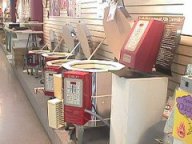 |
|
Equipment Safety: Kilns & Wheels
Click for more information on:
Food Safety • Glazes & Oxides • MSDS Sheets
 |
Electric and fuel-fired kilns are used to heat pottery to the desired firing temperature. Electric kilns, heated by passing electric current through wire coils, are the most common. Fueled kilns may be heated by burning propane, natural gas, wood, oil, coke, charcoal, or other materials. |
Firing temperatures may range from just over 1000 degrees Fahrenheit to over 2600°F, depending on the clays, glazes and other materials being fired. Electric kilns are almost always located indoors; fueled kilns may be located indoors or outdoors.
Depending on how and what you fire, the firing process may create odors and fumes ranging from unpleasant to toxic. Bisque firings may release carbon monoxide as organic materials burn out of clay. Glaze firings may release metallic oxide fumes. Overglaze firings (such as gold, silver and mother-of-pearl) may release odors as liquid solvents burn off. It is unlikely that the fumes from any single electric firing will reach dangerous levels, but the health effects of some fumes accumulate over time. Therefore, it's better to invest up front in safety equipment like kiln ventilation systems than gamble over the long term.
We strongly recommend the use of kiln ventilation systems with all kilns used indoors. There are many kiln ventilation devices on the market from reputable manufacturers like Skutt and Orton. Your choice of which device to buy depends on a number of factors such as type and size of your kiln. Gas-fueled kilns, for instance, will not use the same ventilation devices as electric kilns. Our preferred ventilation device for electric kilns is the Skutt Enviro-Vent. It is a downdraft system, meaning that the vent draws air down into the kiln from the top and exhausts it out the bottom. Besides offering positive control of kiln fumes, this flow-through action also promotes even heat distribution through the kiln body for better firing results.
In addition to concerns about fumes, you should also consider the location of the kiln, effects of radiant heat on your working environment, and the power supply. Your kiln will generate and maintain internal temperatures up to and over 2000°F. Most of the heat is contained in the kiln body, but it can still raise the ambient temperature of your workspace to over 100°F. We recommend that kilns be located and operated in a room separate from your studio workspace if possible.
Generating that much heat takes a reliable power supply. Based on our experience as one of Skutt's leading distributors, we recommend that you HIRE A PROFESSIONAL ELECTRICIAN to set up electric service for your kiln. We have known artists whose homes and studios were completely destroyed by fires attributed to faulty kiln wiring. Don't take any chances on a faulty installation!
Safety reminders about electric kilns:
- Kilns should be kept at least 18 inches away from potentially flammable walls, including wood, drywall, paneling and wallpaper. Check your local building or fire safety codes: they may have additional requirements.
- Place your kiln on an unpainted concrete floor, or on a fireproof slab extending at least 18" from all sides of the kiln.
- Never leave children unattended in the area of a hot kiln.
- Have your wiring checked once a year for potential problems.
- Whenever possible, install a dedicated outlet for your kiln. Do not plug and unplug your kiln, swapping it out on a circuit with other electrical devices.
- Hot kilns produce infrared radiation, which is hazardous to the eyes. There have been reports of cataracts from years of looking inside hot kilns. Use safety glasses, infrared goggles or a handheld welding shield to protect your eyes from this radiation.
- Lumber, cloth, paper, solvents, or other combustible or flammable materials should not be stored in kiln areas.
We have years of experience in mating up kilns and ventilation systems, and assisting in the design of ceramic studios. We can also provide information on installation and safety precautions for gas kilns. Call us and we'll be happy to help.
Potters' Wheels
There are a wide variety of potter's wheels on the market. Most wheels break down into one of two groups: hand-powered (or foot-powered), with momentum imparted by a mechanical system, or electric-powered, with momentum imparted by an electric motor. Potter's wheels are built to handle the dirt and grit associated with throwing clay, but there are still a couple safety precautions to bear in mind.
- Unplug the wheel before cleaning.
- Hose rinsing is not recommended, because it's hard to control where the water goes.
- Keep water away from the control box, motor housing, foot pedal and switches.
- Keep cords and plugs out of water, glazes, and other liquids.
- Moving parts of kickwheels can cause cuts and abrasions, especially a problem with young children. Do not allow young children to use or play on kickwheels.
- Hand contact with wet clay can cause abrasion and dryness of fingertips and hands. Some people are more susceptible or more sensitive to dry skin conditions, which may actually become painful. Use a skin moisturizer, or latex or nitrile gloves if necessary to protect your skin.
- Throwing on a potter's wheel for long periods of time can result in carpal tunnel syndrome caused by an awkward position of the hands and wrists. Pain, numbness, and or pins-and-needles sensations in the thumb and first three fingers are common symptoms. Keep wrists in a straight, unflexed position as much as possible to avoid carpal tunnel syndrome. Take frequent work breaks, too.
- Back problems can occur from bending over the potter's wheel for long periods of time. Exercise and massage may relieve minor muscular pain. Some wheels offer telescoping legs or adjustable seats so you can throw in positions that don't require bending over. Consider these options especially if you have a history of back pain or problems.
|
